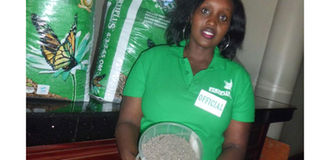Scientist’s advice farmers to boost soils using organic fertilizer

A sales person displays a sample of granular fertilizer. Photo by Lominda Afedraru
What you need to know:
- Farmers practicing mechanized agriculture can use mechanical equipment where planting machines with other farm implements are attached to the tractor and it helps in applying fertilizer during planting
- Most farmers in Uganda measure 50 kg of fertilizer which is applied in one acre land but there are technologies which enable accurate measurement of the quality of fertilizer application in a given area and farmers are advised to liaise with extension worker
There is increasing use of processed fertilizer by large scale farmers in the country with the aim of increasing their farm productivity.
Uganda’s smallholder agricultural sector continues to register one of the lowest fertilizer applications in sub-Saharan Africa.
The statistics indicates that Ugandan farmers use 1 to 1.5 kg per hectare per year against the recommended amount of 200 kg per hectare per year.
Soil scientists and policy makers are now promoting increased adoption of improved agricultural technologies including inorganic and organic fertilizer application as a strategy to rejuvenate improvement of soil fertility in the country.
As such farmers now have the option to choose which organic fertilizer suits best for their soils, with the recent being Fertiplus granular organic fertilizer processed from the Netherlands which is now in Ugandan market.
Other types of organic fertilizer already in the market include NPK containing Nitrogen, Phosphorus and Potassium nutrients, Urea and diammonium phosphate (DAP).
Retired Prof Kitungulu Zake from Makerere University College of Agricultural and Environmental sciences an expert in soil science explaining the importance for farmers to use organic fertilizer to boost the soil nutrient notes that all types of quality fertilizer usage in Ugandan soils is important.
This is because the soil which at one moment was reach in nutrients is no longer the case because effects of climate change such as soil nutrient depletion resulting from soil erosion caused by flooding, heat stress from prolonged drought and continuous tilling of the soils have become a challenge.
To him application of the required content of fertilizer in farmer fields enables enhanced fruiting and root development of crops. Since fertilizers contain some form of acid especially in potassium this helps to propel pests and diseases that are harbored in the soil such as nematodes.
Fertilizers have nutrients and organic matter which helps to retain available water in the soil for good seed germination.
For plant roots to grow well, it requires oxygen and a good distribution of aeration can occur if fertilizer is applied to the soil.
Proper application method
Explaining proper fertilizer usage for all types, he notes that farmers have an option to choose which method to use and these include direct application by hand which can be done by pouring the fertilizer in a bucket and sprinkling it in the farm next to the plant.
Others are broadcast application which is good for bigger areas where farmers use their hands to spread fertilizer all over the farm and thereafter till the land.
There is the dilution application where farmers are advised to dilute it with water and use the solution to water the plants.
Farmers practicing mechanized agriculture can use mechanical equipment where planting machines with other farm implements are attached to the tractor and it helps in applying fertilizer during planting.
Other farmers prefer to till the fertilizer into the soil around the plants to make it available to the roots to accelerate absorption and to prevent run-off in case of rain.
Farmers are advised to study the plants and watch them closely to see if there is over application and vice versa.
With over fertilization you might notice overproduction of foliage without fruit production but with under fertilizer application the plants become weak and undersized.
It is advisable to repeat the application to maintain good plant growth for better yield.
Most farmers in Uganda measure 50 kg of fertilizer which is applied in one acre land but there are technologies which enable accurate measurement of the quality of fertilizer application in a given area and farmers are advised to liaise with extension worker.
Processing method of Fertiplus fertilizer
Ms Peace Quadt the sales manager of Fertiplus fertilizer explaining the processing aspect during its launch in Kampala recently noted that Farm O Feed produces the fertilizer from chicken feed to form mineral subtracts.
The company produces about 70,000 metric tons of fertilizer and since the company is located in the Netherlands which is the primary source of organic material.
It is composited for three weeks to reduce the ammonium level and there after dried for conditioning and sterilization.
Tastes are made in the laboratory to ensure there is no bacterial infestation. What is dried is in form of pellets ready for marketing. So far, it is being sold in 68 countries across the globe with Uganda being one of them.
To her, the advantage of using this fertilizer is that it releases minerals into the soil at slow pace leading to better absorption. The package at the moment is in 25kg costing Shs55, 000.
Standards observed
The Minister for agriculture, Mr Vincent Ssempijja officiating at the meeting observed that before allowing importation any fertilizer into the country, it has to undergo all the quality check standards in order for farmers to access good quality fertilizer.
He recommended that farmers must ensure they use both organic and inorganic fertilizer for improved farm yields as long as it is not fake.
In Uganda, 90 per cent of fertilizer use is by large scale farmers such as tea estate and sugarcane plantations owners.
He advised farmers to form groups and purchase fertilizer at a reduced cost to boost their farm yields.




